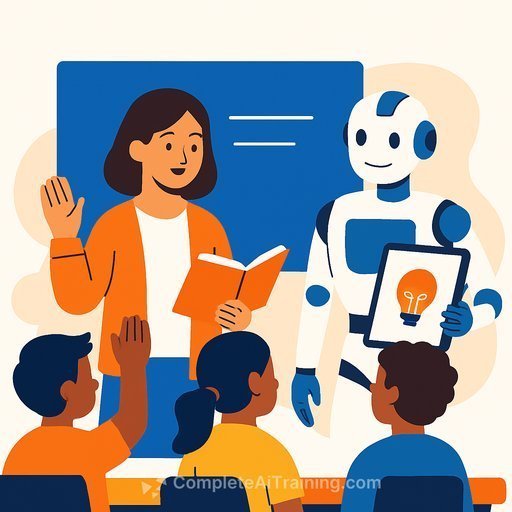AI in the curriculum from 2026-27: What educators need to know
From the 2026-27 academic year, AI will be integrated into the school curriculum for all students from Class 3 onwards. This move is in line with NEP 2020 and is focused on essential AI literacy, workforce readiness, and national competitiveness.
The Central Board of Secondary Education (CBSE) is developing a framework to integrate AI across grades. School Education Secretary Sanjay Kumar said the challenge is to reach over one crore teachers and orient them to impart AI-related education. "We need to move fast so that students and teachers are properly aligned with this technology over the next two to three years," he said.
What's changing from 2026-27
- AI will be embedded from Class 3 as part of core learning, not just as an optional subject.
- CBSE is building grade-wise integration to connect AI with maths, science, social science, languages, and digital literacy.
- Teacher orientation at national scale is planned so classroom practice matches policy.
- Expect staged rollout guidance, sample lesson plans, and assessment templates before the 2026-27 session.
Where things stand today
Pilots are underway that let teachers use AI tools for lesson planning and content creation. Over 18,000 CBSE schools already offer AI as a skill subject from Class 6 via a 15-hour module; Classes 9-12 have it as an optional subject.
Teacher training has started with support from Intel, IBM, and NIELIT. Student uptake has surged: about 7.9 lakh students in Classes 9-10 and over 50,000 in Classes 11-12 opted for AI this year, up from roughly 15,000 and 2,000 when the programme began.
Why this matters for schools and colleges
The policy is consistent with NEP 2020, which called for integrating emerging technologies like AI and IoT. A recent report highlighted that India's 7.5 million IT workforce could shrink to six million by 2030 without a strategic reset.
"AI is changing work, workers, and the workplace. Around two million traditional jobs could be displaced, but eight million new roles may emerge if we create the right ecosystem," said B V R Subrahmanyam, CEO of NITI Aayog. The proposed India AI Talent Mission targets growth across healthcare, education, logistics, and creative sectors.
What students will likely learn at each stage
- Classes 3-5: Simple concepts (patterns, instructions, how apps make suggestions), safe and responsible use, basic digital creation.
- Classes 6-8: Data basics, simple algorithms, problem-solving projects, ethical use, and exposure to visual/low-code AI tools.
- Classes 9-12: Deeper applications, domain projects (health, environment, language), AI ethics, and career awareness. Many schools will keep advanced AI optional while core literacy spreads across subjects.
Note: Final scope will come from CBSE's official framework. Use this as a planning guide to map skills and projects to your context.
What teachers can do now
- Adopt AI responsibly for lesson planning, feedback, and differentiation. Start with one unit and a clear classroom policy.
- Join upcoming orientation programmes; assemble a peer group in your school to share use cases and prompts.
- Build AI-aware assessments: oral defenses, process logs, drafts, and rubric-based evaluation of thinking, not just output.
- Curate a small, vetted toolset and draft consent, privacy, and usage norms for students.
School leaders: 6-point readiness checklist
- Infrastructure: Reliable internet, device access strategy, and shared storage for projects.
- Policy: Age-appropriate AI use guidelines, data protection, academic integrity, and accessibility.
- Procurement: Vet tools for privacy, cost, support, and curriculum fit. Prefer audit trails and admin controls.
- PD plan: Calendar for teacher orientation, micro-credentials, and classroom coaching.
- Curriculum mapping: Integrate AI with existing units; don't add standalone overload.
- Community: Keep parents informed about learning goals, benefits, and boundaries.
Assessment and academic integrity
- Set clear rules on acceptable AI assistance by grade and task type.
- Design assignments that require personal context, real data, or project artifacts that AI cannot fully produce.
- Use AI detection cautiously; it is imperfect. Prioritise process evidence: drafts, reflections, references, and presentations.
Action plan for the next 24 months
- Term 1-2 (this year): Pilot AI in one subject per grade band; collect teacher/student feedback; write a one-page AI classroom policy.
- Term 3-4: Expand to two subjects; run PD on ethics, bias, and prompt quality; standardise assessment templates.
- Year 2: Full-grade integration with mapped learning outcomes; formalise tool vetting and parent communication; set up student AI clubs.
Key numbers at a glance
- Teachers to be oriented: 1+ crore
- Schools already offering AI (skill subject, Class 6): 18,000+
- Students opting this year: 7.9 lakh (Classes 9-10); 50,000+ (Classes 11-12)
- Workforce outlook: potential 2 million job displacement offset by 8 million new roles with the right ecosystem
Helpful resources
- National Education Policy 2020 (Official PDF)
- NITI Aayog - reports and updates on AI and jobs
- Complete AI Training - course paths by job role
A senior CBSE official summed up the intent: when today's third grader graduates in 2035, AI will be a necessity. With coordinated effort from schools, teachers, and industry partners, classrooms can meet that moment with confidence and clarity.
Your membership also unlocks:






